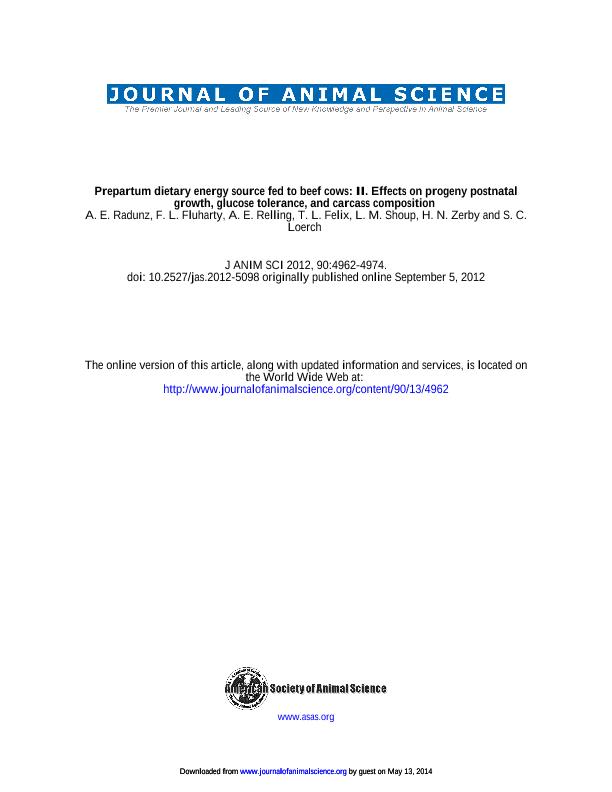Mostrar el registro sencillo del ítem
dc.contributor.author
Radunz, A. E.
dc.contributor.author
Fluharty, F. L.
dc.contributor.author
Relling, Alejandro Enrique

dc.contributor.author
Felix, T. L.
dc.contributor.author
Shoup, L. M.
dc.contributor.author
Zerby, H.N.
dc.contributor.author
Loerch, S.C.
dc.date.available
2019-05-30T23:22:51Z
dc.date.issued
2012-12
dc.identifier.citation
Radunz, A. E.; Fluharty, F. L.; Relling, Alejandro Enrique; Felix, T. L.; Shoup, L. M.; et al.; Prepartum dietary energy source fed to beef cows: II. Effects on progeny postnatal growth, glucose tolerance, and carcass composition; American Society of Animal Science; Journal of Animal Science; 90; 13; 12-2012; 4962-4974
dc.identifier.issn
0021-8812
dc.identifier.uri
http://hdl.handle.net/11336/77435
dc.description.abstract
Mature Angus-cross beef cows (n = 228) were used to evaluate effects of prepartum dietary energy source on postnatal growth and carcass composition of progeny in a 2-yr study. Starting at approximately 160 d of gestation, cows were fed diets consisting of 1 of 3 primary energy sources: grass hay (HY), corn (CN), or dried corn distillers grains with solubles (DG). The CN and DG diets were limit-fed to achieve similar energy intakes as cows fed HY. Following parturition, cows were fed a common diet and managed as a single group. Calves were weaned at an average of 185 ± 6 d of age and backgrounded for 28 d. A subset of progeny (n = 134) was individually fed a common finishing diet until slaughter, when each calf reached 1.2 ± 0.05 cm of backfat. A glucose tolerance test (GTT) was conducted in year 2 on 4 calves/treatment after 41 and 111 d on the finishing diet (DOF). Calf birth weights were greater (P = 0.002) in calves from cows fed CN and DG than calves from cows fed HY, and weaning BW (P = 0.08) was less for calves from cows fed HY vs. CN. Receiving BW, final BW, and HCW did not differ (P ≥ 0.16) among treatments. No difference (P ≥ 0.28) in ADG, morbidity, and mortality from birth to slaughter was observed among treatments. In response to a GTT, increased DOF resulted in greater (P ≤ 0.005) fasting insulin, faster glucose disappearance rate, and greater insulin:glucose area under the curve ratio. Glucose disappearance rate was greater (P = 0.01) in calves from cows fed CN than in calves from cows fed HY or DG. A greater initial insulin response (P = 0.005) was observed in calves from cows fed CN or DG than in calves from cows fed HY. Carcass traits used to measure yield grade did not differ (P ≥ 0.19) among treatments. Calves from dams fed CN had the lowest marbling score (P = 0.03) and intramuscular fat content (P = 0.07). These results indicate that prepartum maternal dietary energy source can alter fetal adipose tissue development and insulin sensitivity resulting in long-term effects on progeny's intramuscular fat deposition. Moreover, present findings suggest that increasing the number of days on a corn-based finishing diet increases insulin resistance in beef cattle.
dc.format
application/pdf
dc.language.iso
eng
dc.publisher
American Society of Animal Science

dc.rights
info:eu-repo/semantics/openAccess
dc.rights.uri
https://creativecommons.org/licenses/by-nc-sa/2.5/ar/
dc.subject
Beef Cattle
dc.subject
Carcass Composition
dc.subject
Fetal Programming
dc.subject
Glucose Tolerance
dc.subject
Maternal Nutrition
dc.subject.classification
Otras Producción Animal y Lechería

dc.subject.classification
Producción Animal y Lechería

dc.subject.classification
CIENCIAS AGRÍCOLAS

dc.title
Prepartum dietary energy source fed to beef cows: II. Effects on progeny postnatal growth, glucose tolerance, and carcass composition
dc.type
info:eu-repo/semantics/article
dc.type
info:ar-repo/semantics/artículo
dc.type
info:eu-repo/semantics/publishedVersion
dc.date.updated
2019-04-26T18:19:05Z
dc.journal.volume
90
dc.journal.number
13
dc.journal.pagination
4962-4974
dc.journal.pais
Estados Unidos

dc.journal.ciudad
Urbana
dc.description.fil
Fil: Radunz, A. E.. Ohio State University; Estados Unidos
dc.description.fil
Fil: Fluharty, F. L.. Ohio State University; Estados Unidos
dc.description.fil
Fil: Relling, Alejandro Enrique. Consejo Nacional de Investigaciones Científicas y Técnicas. Centro Científico Tecnológico CONICET- La Plata. Instituto de Genética Veterinaria "Ing. Fernando Noel Dulout". Universidad Nacional de La Plata. Facultad de Ciencias Veterinarias. Instituto de Genética Veterinaria; Argentina
dc.description.fil
Fil: Felix, T. L.. University of Illinois. Urbana - Champaign; Estados Unidos
dc.description.fil
Fil: Shoup, L. M.. University of Illinois. Urbana - Champaign; Estados Unidos
dc.description.fil
Fil: Zerby, H.N.. Ohio State University; Estados Unidos
dc.description.fil
Fil: Loerch, S.C.. Ohio State University; Estados Unidos
dc.journal.title
Journal of Animal Science

dc.relation.alternativeid
info:eu-repo/semantics/altIdentifier/doi/http://dx.doi.org/10.2527/jas.2012-5098
dc.relation.alternativeid
info:eu-repo/semantics/altIdentifier/url/https://academic.oup.com/jas/article-abstract/90/13/4962/4703493
Archivos asociados
